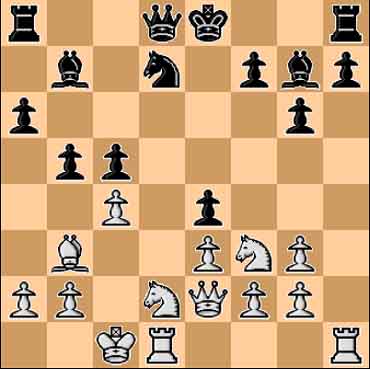Saltzberg (2124)- Steve Brill (1876)
Marshall Chess Club Tournament 1975
Queen's Indian Defense without c4
The Queens Indian Defense was one of my favorite openings playing Black against 1. d4. Here I outplayed a much higher-rated opponent in a real slugfest. After thinking that I had the edge in the opening (turns out, my opponent was slightly better), I tried to exploiting White's positional accuracies and mounted an attack in the middle game. Although both sides committed errors (which neither of us could find in post-mortem analysis, but computer software uncovered only 34 years later) in a deceptively complicated game, my opponent's errors turned out to be worse than mine, and the attack succeeded!
1. d4, Nf6; 2. Nf3, b6; 3. Bf4, Bb7; 4. e3, e6; 5. Bd3, Nh5?!;
(Black goes after the white bishop, but loses time in the process. 5...c5 and 5...Be7 are good alternatives.)
6. Be5?!
(White's bishop should have gone to g5, with an edge. Now he loses time and helps Black battle for control of the center.)
6...d6=; 7. Bg3, Nd7; 8. Nbd2, e5?!
(This bold thematic thrust at the center actually gives White the edge. Better is the more quiet 8...Be7; 9. c3, 0-0; 10. 0-0, c5; 11. e4, h6; 12. Re1, Rc8=.)
9. Qe2, Nxg3; 10. hxg3, g6; 11. de5, de5?;
(11...Ne5, where White maintains the edge, is better.)
12. 0-0-0,
(12. Ba6 is a little better.)
12... Bg7?
(This natural move is inferior to 12...Qe7; 13. Ba6, 0-0-0; 14. Qc4, Bg7, when White only has the edge.)
13. Bb5?
White chooses the wrong square for his bishop. This overly-aggressive gesture only helps Black advance, this time toward White's king, in an equal game. After 13. Be4!, White's better development give him the advantage.
13...a6=; 14. Ba4?
Better is 14. Bxd7=, leaving black with the bishop pair, but unable to castle. Now Black continues with a pawn storm on the queenside.
14...b5; 15. Bb3, c5
Threatening to trap the bishop with 16...c4, but 16...e4! is still better.
16. c4?
(16.c3, e4; 17. Ng1, c4; 18. Bc2, Qe7 and black only has an edge.)
16... e4! Black has the advantage.

17. Ne1, Qf6; 18. Nb1, Ne5
Black has a terrific attack!
19. Nc3, 0-0; 20. Rh4?
(Better is 20. f4, exf3 e.p.; 21.gxf3, bxc4; 22. Bxc4, Bxf3; 23. Nxf3, Nxc4; 24. Qxc4, Qxf3, but Black's still up a pawn.)
20... g5
(20... bxc4!; 21. Bc4, Nxc4!; 22. Qxc4, Qxf2 gives Black a winning attack.)
21. Rh1, bxc4; 22. Bxc4, Nxc4; 23. Qxc4, Qxf2;
(White loses a pawn as his position continues to crumble.)
24. Nc2, Qxg2?
(Black give White a chance to escape by taking the wrong pawn. Better is 24...Qxg3!; 25. Qc5, Rac8; 26. Qf5, h6; 27. Rd2, Rfd8 with a big advantage due to the extra pawn.)
25. Rhg1?
(After 25. Qxc5!, h6; 26. Qb6, Bc8; 27. Rxh6, Be6; 28. Rhh1, Rad8; 29. Qxd8, Rxd8+; 30. Rxd8+, Bf8; 31. Qe7, Rf2; Black only has an edge.)
25... Qf3; 26. Qxc5, Qg4; 27. Nd4, Rhc1! 28. Qe7?
(28. Qf5, trading queens, is better.)
28... Rab8?
(28...Bd5!; 29. Kb1, Rd8; 30. Ka1, Rd7; 31. Qc5, Rad8, 32. Rdf1, h6; maintains Black's advantage.)
29. Rgf1?
(This gives Black his big advantage back. After 29. Rdf1! Qh5; 30. Rf5, Qh2; 31. Qxf7, Kh8; 32. Rgf1, Qxg3, 33. Nc2; Black still stands better.)
29... Bd5!
Protecting the f-pawn and bringing another piece to bear against the enemy king. Black has a won game.
30. Rf5, Bxa2; 31. Rdf1?
(31. Rc5! staves off immediate loss.)
31... h6;
(White is lost.)
32. Rxf7, Bf7; 33. Qxf7+
(If 33. Rxf7, Bf8! 34. Qa7, Rc3! 35. bxc3, Ba3+; 36. Kc2, Rb2; 37. Kc1, Rf7; 38. Kb1, Qd1 mate.)
33...Kh8; 34. Nf5, Bxc3; 35. Rh1, Bxb2+; 36. Kd2, Bc3; 37. Kc1, Be1+; White, about to be mated, resigns.







